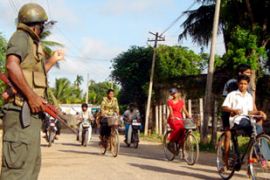Ceasefire call by Sri Lanka rebels
Government forces bomb LTTE artillery and command positions in the island’s north.

But the Sri Lankan government on Monday rejected the truce offer, demanding the separatist rebels surrender or be destroyed.
| In depth | ||
|
“The government will not go for a ceasefire with the LTTE. We will not have any form of discussion with the LTTE.
“We have already told them to lay down arms and there is no change in our stand,” Maithripala Sirisena, the agriculture minister, told parliament.
Mahinda Rajapaksa, the Sri Lankan president, in a speech to parliament last week, said that the Tigers will be destroyed unless they lay down their arms and surrender.
Air raid
Despite the ceasefire call, Sri Lanka’s air force bombed targets near Tiger strongholds of Paranthan and Poonaryn.
“Jets engaged a Sea Tiger command centre a kilometre west of Paranthan junction and an artillery position 6km southeast of Poonaryn,” Wing Commander Janaka Nanyakkara, an air force spokesman, said.
The rebels have repeatedly said they want a ceasefire, and have accused the government of throwing out a 2002 Norwegian-brokered truce.
In January, Rajapaksa’s government pulled out of the pact – which both sides had all but ignored since 2006 – and said the LTTE had only used it to re-arm.
Military surge
A ceasefire would likely benefit the rebels as the military claims to have begun closing in on the LTTE’s administrative headquarters of Kilinochchi in northern Sri Lanka, about 330km north of the capital Colombo.
The military has all but cut off access to the war zone for journalists, so it is difficult to get a clear picture of what is happening at the front.
Most analysts agree the military has steadily seized Tiger-held territory.
The Tigers have fought the government since 1983 to establish a separate homeland for Sri Lanka’s Tamil minority, which has complained of marginalisation by successive governments led by the Sinhalese majority.
